
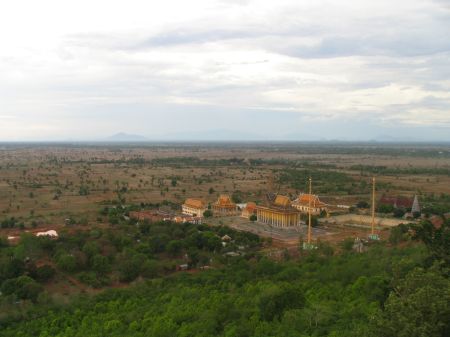
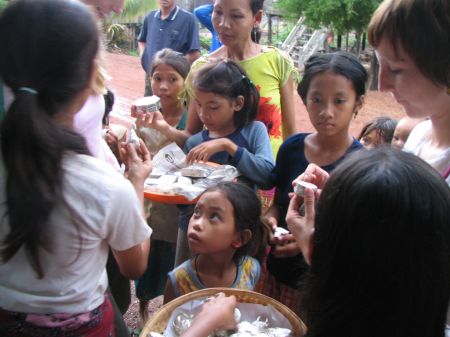
It is weekend again and I am planning to visit Phnom Udong (Phnum Odongk) with two of my colleagues, Maraille and Lydia. I have been to Udong before and will avoid repeating what I wrote in the other article and rather provide some more pictures.
We have an extensive and late breakfast in Phnom Penh before we leave. We arrange a car with a driver (a Toyota Camry with the steering wheel on the left hand) for $24 both ways. Then we start.
The road is quite busy at this time and there is a lot of traffic in the outskirts of Phnom Penh. It is getting better while we are coming closer to Udong.



This is a view of Udong Mountain from national road 5.

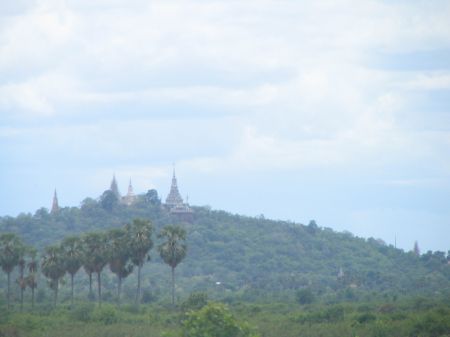
If you want to go to Udong you leave national road 5 when you see this sign on your left. Udong is very easy to find as it can be seen from far away along the national road.

The mountain with the tops of various stupas is in the centre of this picture.
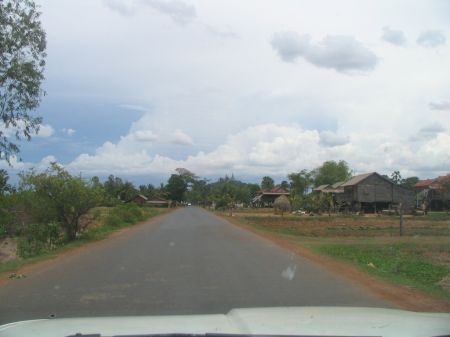

We start walking up the mountain on its southern side, where it is not very steep. First, we reach a smaller hill top.
This is the view. Pagodas can be seen all over the place in any direction from up here.
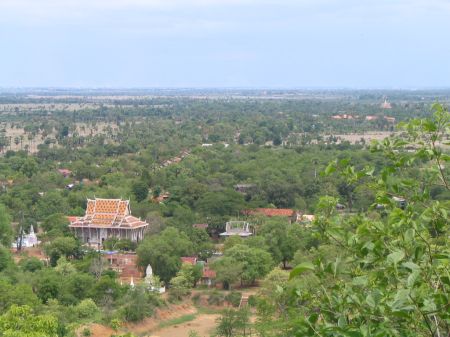
There are two separate buildings on this hill top. The one to the right looks like a temple, but it is a mosque. I remember reading an excellent text by William Collins about the Chams in Cambodia. Chams are a Muslim minority, successors of the Kingdom of Champa which used to exist on the territory of today’s Vietnam. Among other things, Williams reports that Udong is a spiritual and religious centre where the language and culture of the Chams is maintained and preserved today.
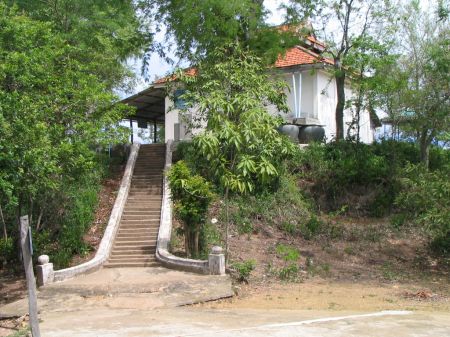
We meet three elderly men resting in hammocks. They are very friendly and point out to us that they are Cham and that the building is a mosque. When I indicate that I would like to take a picture they first get dressed carefully.

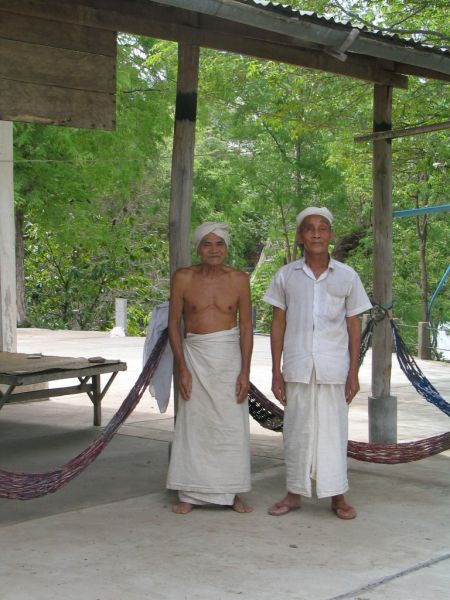
Then we visit the other part of the hill top. There is a stupa and some Buddha statues under a roof.
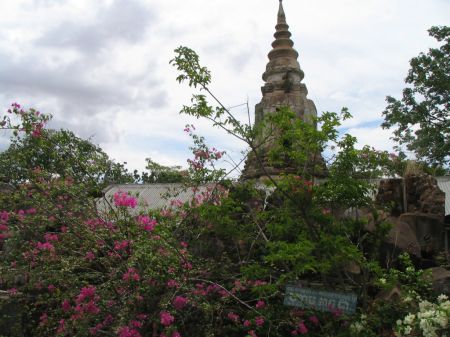
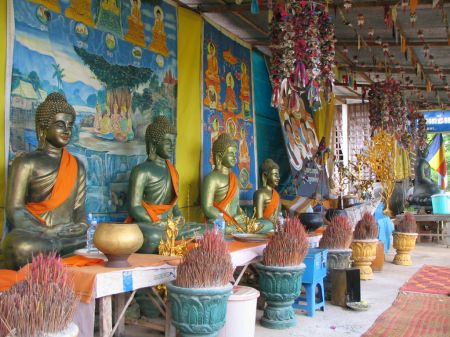
From here we walk down this hill and up another one to the ruins of a hill top temple next to it.
This is inside of what is left of the temple. In the background, in front of the last pair of pillars, there is a huge Buddha statue with the head and large part of the torso missing.

Parts of the statue are distributed everywhere between the walls of the building.
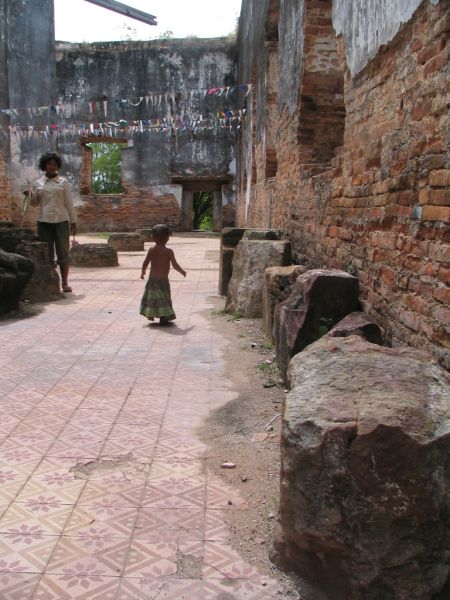
This is the nose.

There is a nice view from up here.

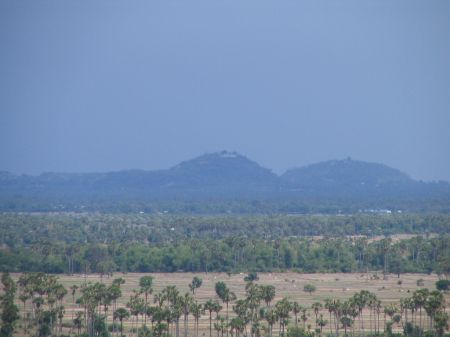



This is the view towards the stupas on yet another hill top.


We have some rest and a soft drink here when it starts raining. We find cover under the roof next to the tree to the right.

It rains for some time and we share the roof with some locals, or rather they share it with us.

One of the stupas is under renovation.


This is a pretty new stupa which is also the highest among those on this mountain. In it, there are some eyebrow hairs and a piece of bone from Buddha himself, which used to be kept in a monument close to the Railway Station in Phnom Penh until not so long ago.

There are countless pagodas, close and far away, that can be seen in any direction from up here.


From left to right: Maraille, Lydia and myself.
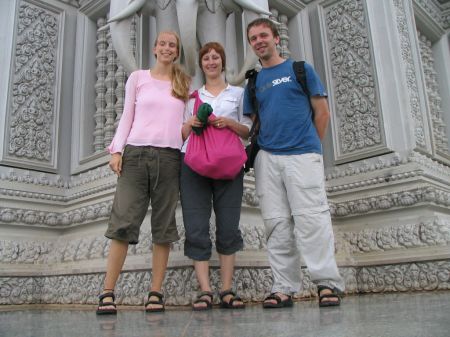
It is rare to be without company up here.

Then we climb down the mountain and enter the car. We read in the guide book that there are many silver smiths among the local Cham population and on the way back, and we visit one of the villages to have a look.
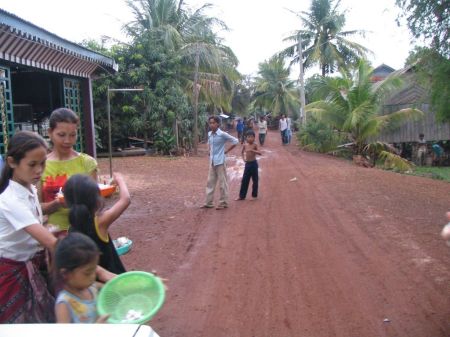
After we leave the car we don’t have to wait long until we are surrounded by kids who offer all kinds of silver products. We spent some time investigating what they sell, but we don’t buy anything. At least Maraille entertains those kids quite well with her digital camera.


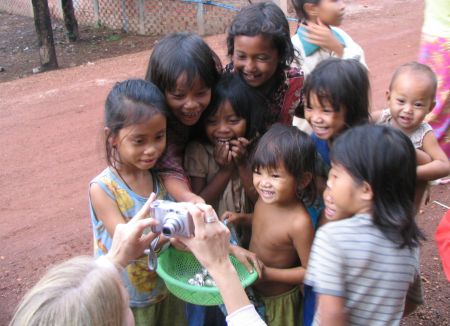
Then we drive back to Phnom Penh, where we have diner and later some cocktails.
I read your blog and saw the photos about the Chams now settled in Cambodia’s Udong -with lot of
interest. I am one of those Hindus now living in Thailand, who want to learn more about the Cham culture and to correspond with anyone who knows more about Chams. Original Chams were not Muslims, but Hindus. When the Chinese pushed them out of Central Vietnam, they moved down South and also to Cmabodia. Can you provide me more links to know more about the present Cham population and how they live in Southern Vietnam and borders of Vietnam and Cambodia? Regards.
Sathya- usatya31@yahoo.com. Many thanks for your informative blog.
Dear Sathya,
Thank you very much for this comment; I certainly share your interest in Chams, their culture and history.
I am surprised you say the Chinese pushed the Chams out of Champa, as I was under the impression it was the Vietnamese state expanding to the south, colonizing Champa and causing waves of Cham migration to Cambodia till the demise of Champa in the 17th century.
I am not aware of meaningful information about the Chams on the internet but would be very happy if you find something and share it with me. The best there is, in my view, is the following text by William Collins, with an impressive list of literature to follow up on, unfortunately most of it in French:
http://www.cascambodia.org/chams.htm
I am at the planning stage of my PhD research about minority rights in Cambodia, will be in Canada until the end of the year and hopefully in Cambodia starting spring 2007 for fieldwork.
Take care,
Stefan
Just found a page with beautiful photos of Cham sites in Vietnam:
http://gilkergu.club.fr/champa/champa.htm
Dear Sathya,
You may find this interesting:
http://ecaimaps.berkeley.edu/animations/2003_03_khmer_animation.swf
Stefan
Dear Stefan,
It jumps out of your blog page you love and respect “my” people. Actually I’m not a Cham just a Khmer, like we say in France, un laique. Many thanks for these lovely pictures and truly nice comments.
How’s your Ph. D going? Minority rights in Cambodia? Boy, you picked up one of the most unexisting subjects about Cambodia. Really Hope you find some good readings in English, French or Cambodian, in this case you might have to go through some philology stuff… that could be very tricky as you know lots of valuable writings went asthray through various wars and oral history is almost the only thing people remember from their past.
To me, the Khmer’s genuine sense of Hospitality and kindness challenges the very notion of “Ethnic Minorities” and so on… I’d really love to read your findings and how you get through this issue.
Take care
Sam
Dear Sam,
Thank you for your very interesting message and kind words. Yeah, I do love and respect your people and look forward to return to my beloved Cambodia, unfortunately only in spring 2007.
PhD is going well but slow. It is strange indeed writing about minorities in Cambodia while being in Canada. Minority rights in Cambodia are not a non-issue exactly and there are a few excellent texts written on various groups. Unfortunately some of them in French and Cambodian (as you suggest) which unfortunately I cannot read.
Oral history is important indeed and I am looking forward to empirical research in Cambodia next year, talking to members of various groups to get their view, which is what it is all about.
I agree that the Khmer’s approach to minorities is very benign indeed, ethnic mobilization and conflict are at a very low level compared to any other country in the region. Accordingly, I want to argue that people should attent to the Cambodian case because the country is more successful in managing state-minority relations than any of its neighbors (or most other diverse countries). Much to learn for them from Cambodia.
Yet I would also like to point out that hospitality may be the right approach to those groups that came as immigrants, like the Chams. However, there are other groups, more specifically: various hill tribes, who did not choose to come to Cambodia. Rather, Cambodia came to them. They have been longer than the Cambodian state existed so they are not exactly guests. Yet their homelands, forests and institutions are being destroyed at a rapid pace.
It will be my pleasure to keep you informed of my research while we go along. Maybe we meet up one day in Cambodia.
Be well,
Stefan
Dear Stefan,
Many thanks for your very well informed reply. You read between the lines all right 😉 , but I didn’t mean “minorities rights” issue is a non-issue issue 😉 , nor did i find it strange you do research from Canada, many scholars did before you…Anyway if it wasn’t called for, I’m sorry.
Sure I’d love to meet up in Cambodia in spring 2007 or any other time we happen to be there at the same time. I live in France, left Cambodia in 1979 after our Staline-like home-made tragedy.
You’re right about everything you wrote in the last post you made.
Cambodia in its “glorious” era was like Napoleon, turns out nowadays that Napoleon was a bloody (UK term, not to take litterally,…yet…) invader. So you’re right, Cambodia came to many other places in South-East Asia.
There’s a french website (below) with first-hand observations about how the poor was treated in Angkor time when a 13th century Chinese ambassador traveled to Cambodia and wrote that poverty-striken people were treated lower than trash. And you still can hear this in everyday conversations among “Modern” Cambodians living abroad, many still believe deep down there that if the indigent lives in utter destitution it’s because they are genetically stupid, lazy… regardless of what they are: Chams, Hill Tribe people or any other “uncivilized” human groups. Civilization thing might be the key here as well as slavery, indian curse of Untouchability as Khmer Brahman figures are considered all mighty and “godly” good (e.g. “Ta Ey Sey” in Khmer, sorry, sort of hermits – only male – with long white beard and hair put into a bun )
http://www.kh.refer.org/cbodg_ct/kh/culture_kh/hist/esclave.htm
It’s in french, sorry I still don’t get straitght whether you speak french.
Look forward to reading your finding as you go. Looks like a very good team.
Cheers
Sam
Hi Sam,
I do value your response and did understand you did not imply minority rights are not an issue. It will be my pleasure to meet you in Cambodia. I expect to be around for at least one year and hope you will be around at some point.
The reference to France is well chosen, in fact even in Cambodia it was colonial France that drew the lines on its colonial maps which later became borders of a nation state and incorporated the homelands of previously self-governing minorities. This is certainly as bad if not worse for the Khmer Krom minority in the Mekong Delta. Did you read that some Khmer Krom organizations now claim self government rights? Some groups in the US even declared a transitional government in exile earlier this month, claiming suzerainty over Kampuchea Krom and electing a prime minister.
http://www.cambodiapolitics.org/news_06/the_cambodia_daily_06/cd_06_06/21_cd5.pdf
France is interesting for other reasons. Did you know that less than 200 years ago, a majority of people on the territory of todays’ France did not speak French? France is the country that most aggressively assimilated minorities on its territory and the only state left in the West that does not grand some measure of autonomy to its only remaining national minority on Corsica. Funnily, while France is arguable the one state in the West that is most hostile to minority rights, it is French populations in other countries pressing hardest for minority rights, in particular the Quebec people here in Canada. What a hypocrisy!
Your observation about Modern Khmers abroad is to a good extent true also of modern Khmers in Cambodia who associate hill tribes (not so Chams in my observation) as uncivilized. Accordingly, their assimilation into the Khmer culture is seen as a noble project from which they will benefit. This attitude is certainly not unique to Cambodia and much of could be changed if people better understood the culture of hill tribes and what they actually want. Raising this kind of awareness is what I hope to be able to make a contribution to.
Thanks a lot for the link. Unfortuenly, I do not speak or read French, but will try if the text makes still some sense after a google translation.
Be well,
Stefan
Hi Stefan,
Many thanks for the link and I do hope i could visit Cambodia while you’re there. A year is long enough to check out everthing. By the way, I met a Canadian lawyer guy about 8 years ago, he worked for the UN/Int’l Criminal Tribunal for the former Yougoslavia, he was also involved in a project aiming at bringing ex-Khmer Rouge leaders to court. Didn’t keep in touch with him and found his business card by chance then sent him an email just in case he still has the same email address, no reply. Maybe you know him, his name is Ken Roberts, Associate Legal Office in 1998 or so… Yesterday, “Pol Pot” jury was sworn in, maybe he’s still working on it, a highly controversy issue.
So where are you headed for? Phnom Penh or Siem Reap (Angkor Vat) ? I very sadly remember the shooting in Siem Reap that killed a 2 year old Canadian boy a few years ago. Do you know whether the couple is still there.I still remember his father bursting into tears. It was heartbreaking to see him like that.
As a matter of fact, I’d read about the Khmer Krom march in San Francisco on June 26 ’06 as you also mentioned. And thanks for the link, peacefull march, that’s OK. On the other hand, I don’t get it why the San Francisco KK association want suzerainty, don’t they have other fish to fry?
You are so right about France. To put the matter in a nutshell, I started writing a book I called “Une France raciste” : “A racist France” about 7 years ago after I got fired. Maybe one day, I’ll finish it, the reason is there are very “good and bad” French people. Out of consideration for the first, I still hesitate and it’s now a TRUISM after the huge urban riots that burst out last years, facts talk about themselves. You might know of this website: http://www.f..kfrance.com. I take some comfort visiting it when it’s too outrageous like when I was eating out in a restaurant with a French friend; we were seated near a dressed-up old man. All a sudden he started talking to us and went “if there are not enough jobs in France it’s because of the CHINKS”. Out of consideration for my friend, I nodded in agreement. My friend didn’t say anything neither, he’s jewish, he knows what it’s all about.
“Hill Tribes” is what many Khmers also call “Phhnong”, and it’s a very extremely insulting term. You’re right the Chams don’t face this directly, but they used to be and sometimes still are referred to as “A Cham”. The “A” word is a very derogatory term. I happened to talk about it last week with a Khmer friend, he’s dating a Cham girl and told me they don’t say they are Cham unless they’re sure nobody’s gonna offend them.
Raising awareness is the right approach. Let me know if i can be of help with the French google translation in case it doesn’t make sense.
Thank you for what you do for my people.
Take care
Sam
Dear Stefan,
If you wouldn’t mind, I would like to know more about your research on minority rights in Cambodia. I am a Cham(Vietnam)-French-American woman researching the Cham and their Diaspora as I make a documentary about my Balamon/Ahier Cham grandmother’s reburial in Viet Nam. I am interested in how the Cham are treated in both Viet Nam & Cambodia. I am also curious which vestiges of matrilinealism (if any) have been retained by Cambodian Cham.
I wonder also if you know of any Cham in Canada. I am trying to compile accurate population counts for the Cham who have left Viet Nam and Cambodia. I read that some had settled in Canada, but I have no idea how many.
Thank you for your work.
Best wishes,
Julie Thi Underhill
Portland, OR, USA
http://www.jthiunderhill.com
jthiunderhill@yahoo.com
Hi Julie,
Thanks for your kind message. Your story and planned documentary sound very interesting and analyzing and comparing the treatment of Cham in Vietnam and Cambodia are a project of endless fascination.
Unfortunately, in terms of research findings, I don’t have much yet, other than the content of my master thesis which is on my blog. I am sure you have seen the text on the Cham by William Collins, in my view the best and most comprehensive treatment of Chams in Cambodia. I don’t know of any text as insightful about Chams in Vietnam.
Unfortunately I don’t know any Cham in Canada and have no information about their numbers. I also don’t have any insights specifically on vestiges of matrilinealism among Cham in Cambodia.
I would be very curious to see your population counts of Cham in Vietnam and Cambodia.
I can supply you with drafts, methodology paper and the like of my current research project, but this would not be very helpful to answer your questions. Meanwhile, please keep me posted on interesting information and sources of information.
Best,
Stefan
I’ve been doing a bit of informal research on Chams in Udong and their mythical ways. I’m Cham-American and have been very interested about these Chams. I think my family came from that region because the wife of the old man that maintains the Ta San mosque on Udong read a poem from a scripture (saw it on youtube) that I’ve heard my grandmother read to me before.
Through some of the videos and posts I’ve seen online, I’ve learned a bit about them. So most of what I know is through oral history. But I hope that your research will lead to more reliable and intelligible sources of information.
Rohany K.
delite79@gmail.com